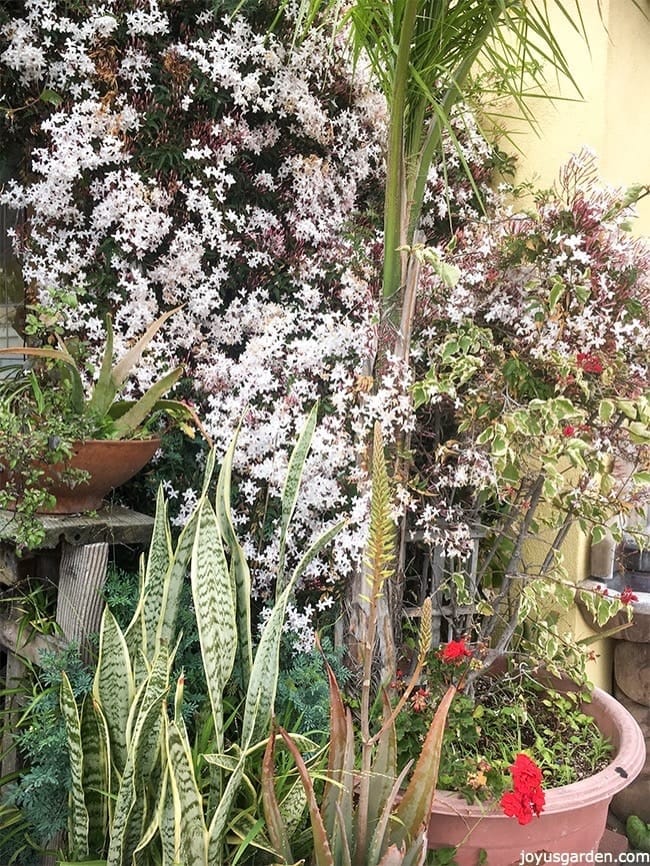How To Grow Pink Jasmine Vine
People love Pink Jasmine, aka Jasminum polyanthum, because of its strong, sweet scent and abundance of blooms. I bet you’ve already seen it flowering like crazy around your town and are wondering how to grow Pink Jasmine Vine so that you too can also enjoy that delightful aroma. After all, who doesn’t want a plant that gets madly covered in scented blooms?
And that is what makes this jasmine a crowd pleaser – that abundance of starry white blooms in clusters. The vine gets covered with so many blooms that you can’t even see the foliage. The Pink Jasmine Vine’s a very popular landscaping plant because it’s easy to find, grows fast and is easy to care for. For landscaping, it’s very versatile. It can be seen on trellis’ (which they fast outgrow), walls, arbors, and chain link fences as well as growing up into trees and phone poles.
Here are some tips on how to grow Pink Jasmine Vine so that you can start enjoying its virtues:
Size
This twining vine can grow up to 25 feet; it’s not a small scale plant. If you’re looking for an accent in your garden this one’s not for you as you’ll need to give it room to grow. Pink Jasmine Vine grows fast, dense and will attach to anything close by. Don’t plant it next to a tree because it’ll crawl up into & could eventually take it over.
This vine won’t attach itself to a wall – it’s not a clinging vine like the English Ivy. Because it’s a twining vine, you’ll need to give it a means of support and training. This is big fast growing vine, so if you’re planting more than 1, space them about 10 feet apart.

This is what can happen if you let your jasmine grow with no control. And this one’s planted in a pot!
Best light conditions for your Pink Jasmine:
Pink Jasmine needs a minimum of 4-5 hours of sun daily. It’ll grow in the shade also but will look leggy & won’t flower. This would have no appeal. Part sun will do as long as it’s nice & bright. On the coast it can take full sun. If inland, it needs protection from the hot sun or it’ll burn (not to mention the fact you’ll need to give it more water).
If you’re in a colder coastal zone, you might consider planting it in front of south or west facing wall to give the vine additional warmth.
Hardiness:
It’s hardy to 10-15 degrees. That would be to USDA Climate zone 8. In climates on the colder end of that scale, it becomes semi-deciduous & starts dropping some leaves.
How often to water your Pink Jasmine vine:
Watering always depends on your climate, humidity & soil conditions. As a general rule, Pink Jasmine needs to be watered regularly. It can go drier once established but will appreciate & look better if deeply watered every 2 weeks. During the colder months water your Pink Jasmine once you see the soil is drying out. Like all plants, it needs less water during this season & you want to avoid root rot (if your soil is drains well, then you have to worry about this less).
While your Jasmine is establishing, the 1st year or 2 after planting, you need to water it more often. This will promote a healthier root system that will make the plant more resistant in years to come.
Fertilizing:
Pink Jasmine isn’t fussy & really doesn’t need it. I’ve found applying a good dose of organic compost once a year (in late winter/early spring) will make it happy. If you’re the kind of gardener who loves to fertilize, then do so during spring to encourage flowering & growth with an evenly balanced fertilizer like 10-10-10 or 15-15-15.
Pests:
I haven’t seen this plant be bothered by too many pests. Aphids could be an issue, especially in spring on the tender new growth, but you can easily spray them off with the garden hose. If mealy bugs or spider mites appear, you can control these with insecticidal soap or horticultural oil.
Soil:
Pink Jasmine isn’t too fussy about its soil condition. Just make sure the soil is loose & well drained – a loamy soil is best. I always plant everything with a good dose of compost. If you’re planting this vine in a container, the use a good quality, organic potting soil.

Flowering:
If you want to get lots of flowers, then give it plenty of sun (not hot scorching sun because it’ll burn). Pink Jasmine blooms only once a year in late winter/spring. You might an an occasional bloom in the summer too.
So, enjoy the sweetly scented blooms while they last! I love the pink buds (hence the common name) & love how they look in bouquets. This plant is also very popular with butterflies & hummingbirds.
Pruning:
Because Pink Jasmine is a vigorous grower, you’ll have to do some pruning to to keep it from taking over. So, you’ll need to prune regularly thru out the year.
As I said, it’s a dense growing vine & grows back on itself (it literally flops over) if there’s nothing for it to grab onto. In other words, it smothers itself & then needs to be cut almost cut the way back. For this reason, it’s best to keep up with the trimming.
Those masses of pretty blooms don’t last forever, & once they die, can make the Jasmine look pretty sad. This is why a good pruning pruning after the flowers die is recommended as this will keep it looking neater. Be sure to keep your pruners clean and sharp!

You can already see some of the dying flowers in this Pink Jasmine. Now imagine when all of them are dead. Yes, you’ll want to prune that out.
Jasmine as a container plant:
You can also grow Pink Jasmine Vine in a container. If you go this route, be sure it has a big pot to give the roots room to grow. As a houseplant, it’s often sold on rings or globes when flowering. I’ve used it for weddings & parties but haven’t grown it as a houseplant for the long haul. It would need good, strong sun & regular water. It’s also sold in hanging baskets which are fine for 1 season & then need transplanting.
Please share your experience with this pretty twining vine in the comments below. I love reading about your gardening adventures.
If you’re looking for more twining vines you can also check out: A Plant With Major Attitude: Cup Of Gold Vine (Solandra maxima) and Stephanotis Vine Care.
Happy gardening & thanks for stopping by,

YOU MAY ALSO ENJOY:
- Things You Need To Know About Bougainvillea Plant Care
- Bougainvillea Pruning Tips: Everything You Need To Know
- Bougainvillea Winter Care Tips
This post may contain affiliate links, you can read our policies here.








where could I buy a pink jasmine?
Hi – It depends on where you live. I live in Tucson & they’re sold at all nurseries & big box stores too. They may be sold as a houseplant in your area. There is a seller on Etsy who offers them in 4″ pots so you could check that out. Nell
Hi. I am planting this jasmine against a fence. Given how densly it grows, what distance from the fence should I plant it? Thank you.
Hi Annette – I always planted it about a foot away from the fence. Like with any vine, I angle the plant towards the fence, trellis or means of support so you can easily train the top part to attach. Nell
What state are you located in
Hi Karen – I lived in CA for 30 years & moved to AZ 1 1/2 years ago. Nell
Walking into Ralph’s grocery store in san diego i was hit with the wonderful smell of Jasmine. I put it in my cart! It’s a polyanthus. Going to plant close to window so smell comes in!
Kathy – They bloom in the late winter/early spring in Southern CA so you find them in abundance at this time of year. The scent is sweet indeed! Nell
Our Jasminum Polyanthum looks very sad at the moment, some green leafs still on some stems,
but there is a lot of down leafs and stems, do we did to cut these off? Or do we cut it right back ?.
We have had a very cold spell, as most gardeners most have had.
Hope you can help us, we planted this last years it is a new plant.
Thank you
Hi Muriel – JP is hardy to around 20F. I’m not sure what you mean by down leaves & stems … dead? If the stems look dead, you’ll have to cut back. Nell
Hi! Great article. I live in South East Spain, gardening zone 10a. I’ve just bought a jasmine polyanthum and was thinking of growing it up a trellis on my East facing kitchen wall. Because of the mass of the house it would be in shadow from around 2 pm in summer and from around 12noon in winter. Would this be enough sunshine for it to bloom? Or would I be better putting it against a south west facing wall? I was a little concerned that south west might be too hot in the afternoons.
Hi Elaine – JP will burn in all day hot sun. Conversely, it’ll grow in the shade but be leggy & won’t bloom. 4-5 hours of sun a day is best, definitely not a SW exposure. Nell
Hi Nell! We live in La Crescenta, CA. I have a chain link fence that gets afternoon sun. I’d love this fast-growing, showy Pink. Do you think it will do ok with the afternoon sun? (Our neighbor’s side is to the West, so I’m thinking it might get scorched a bit on their side…) Thanks!
Hi Sue – I’m not familiar with the climate/sun intensity in La Crescenta. JP does best in 4-5 hours of sun a day & will burn in hot afternoon sun. It grows beautifully along the coast in the Bay Area, San Diego & around Santa Barbara. I’ve only seen a few here in Tucson but they’re growing in a north exposure. Nell
Will I be able to grow this in southern Illinois? I want it outside. Not really in a pot to bring in for the winter.
Hi Amy – This plant is hardy to 15F. No – you have to bring it indoors or grow it as an annual. Nell
Hi Nell,
I have mine in a container on the roof, and after reading your comments above, I think it is getting too much afternoon sun. I live outside of Los Angeles on the coast. It looks generally unhealthy, besides having some dry, burned leaves. The unburned leaves are a splotchy light green, the way heavy feeders get when it’s time to fertilize. Do you think this might just be general stress from too much sun?
Hi Ev – Yes, I’ve found that Pink Jasmine doesn’t like the hot, afternoon sun. It could also be drying out in the pot &/or getting too much wind. Nell
I live in Dallas just purchased a pink jasmine vine I want to move it into a pot any advice
James – They do fine in pots & transplant well. Use a well drained rich mix. How big a pot you get depends on the size of the plant. Nell
I live in the Oklahoma City Metro Area, Zone 7. I mentioned to my mom that I was thinking about planting some Jasmine; I was intending to buy something hardy to zone 7. However, my mom went to Home Depot and purchased two Jasminum Polyanthum plants and gave them to me as a gift. I planted them today. Do you think I will be able to keep them alive through the winter? Or should I bring some of it inside in pots for the winter? Or should I give up and plant a hardier variety of jasmine next spring?
Robin – They’re hardy to zone 8. Jasmine can be tricky to keep alive indoors. You can look into Hardy Jasmine & Winter Jasmine. Nell
Hi – this is so helpful. Thank you!
I have some of this in my backyard and I’m now realizing it is growing all over a tree I have. Should I prune this? Should I just cut it all away from the tree?
Karen – You’re welcome! Depending on the type & size of the tree, it could eventually smother out some of the foliage. Nell